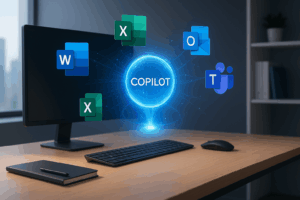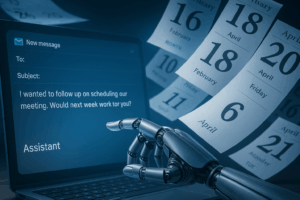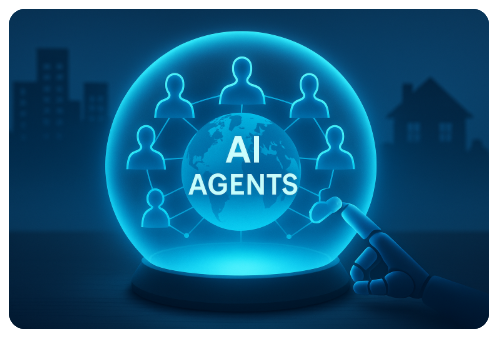Introduction:
Imagine having an AI-powered assistant that can manage your daily tasks autonomously, from booking appointments to drafting emails. This is no longer science fiction – autonomous AI agent services are emerging that handle routine tasks with minimal human input. Tech giants are leading the way with case studies like Google Duplex – which can make phone calls on your behalf – and Microsoft 365 Copilot – which helps automate work across Office apps. These agents leverage advanced large language models (LLMs), integrations with various services, and APIs to perform tasks in a human-like manner. In this article, we’ll explore how these AI agents work, their key features and use cases, the growing trend of AI agents executing tasks like scheduling and email handling, and what the future holds for both consumers and enterprises.
What Are Autonomous AI Agents?

Autonomous AI agents are intelligent software services designed to execute tasks, make decisions, and interact with other systems without needing constant human guidance. Unlike traditional automation (which follows fixed rules), these agents use AI – including machine learning and natural language processing – to adapt to new situations and handle complex, open-ended tasks. In practical terms, an AI agent can take a high-level goal (“schedule a meeting with Bob next week” or “clean up my inbox”) and carry out the necessary steps across different applications to achieve it. Modern AI agents combine powerful LLMs (for understanding instructions and generating responses) with connectivity to tools and data (via APIs and integrations) to act on those instructions. This means an AI agent might read your calendar, send emails, or call a service – all autonomously once given a directive. These capabilities represent the next evolution of automation, freeing users from mundane tasks and allowing them to focus on more important work.
Case Study: Google Duplex – AI That Makes Phone Calls for You

One of the earliest and most famous examples of an autonomous AI agent is Google Duplex. Announced by Google CEO Sundar Pichai at I/O 2018, Duplex was introduced as an AI system that can conduct natural conversations over the phone to perform “real world” tasks. Duplex’s hallmark is its human-like speaking ability – it inserts natural-sounding pauses and “ums” into its speech, so that people on the other end of the call often can’t tell they’re speaking with an AI.
Core features and use cases: Google Duplex was designed primarily to schedule appointments and reservations by phone. Users can ask Google Assistant (which Duplex is integrated into) to book a restaurant table or a hair salon visit, and Duplex will call the business to converse with the staff and secure the booking. It can also check store hours or inventory by calling stores, and update your Google Search/Maps with that info. Duplex even handles pesky tasks like waiting on hold: with the “Hold For Me” feature, the AI will stay on the line for you during long hold times and alert you when a human comes back. Other use cases rolled out include checking restaurant wait times, purchasing movie tickets, and helping reset lost passwords. These real-world skills make Duplex a personal concierge for tedious calls and inquiries.
Underlying technology: Under the hood, Google Duplex uses a sophisticated conversational AI architecture. It’s built on a recurrent neural network (RNN) and employs Google’s natural language understanding and generation techniques to carry on dialogue. For the voice, it leverages DeepMind’s WaveNet technology to generate remarkably lifelike speech audio. Duplex’s AI is designed to handle tasks autonomously but is smart enough to know its limits – if it encounters a conversation it can’t navigate, it will escalate to a human operator or inform the user that it couldn’t complete the task. This ensures reliability in real-world scenarios. Duplex also integrates with Google services (Calendar, Gmail, etc.) to use information you’ve already provided (like your availability or preferences) when carrying out tasks.
Impact and availability: Google Duplex represented a major leap in how AI can interact with the world on our behalf. It streamlines everyday tasks – saving users time from making phone calls themselves – and showcases how natural AI-human interaction can be. Since its debut, Google has expanded Duplex’s availability. Initially limited to Pixel phones in a few U.S. cities, it later rolled out to Android and iOS devices via Google Assistant and is now available in 49 U.S. states and numerous countries worldwide. Businesses have had to adapt to getting calls from an AI, and generally, Duplex has operated with proper disclosure (the AI will identify itself as Google Assistant) to avoid confusion. Google’s continued investment in Duplex’s voice technology (while shuttering a web-based version in 2022 to focus on phone interactions) underscores the importance of voice-based AI agents in managing day-to-day tasks.
Case Study: Microsoft 365 Copilot – Your AI Assistant at Work

Another high-profile entrant in autonomous agent services is Microsoft 365 Copilot. Launched in 2023, Copilot is an AI-powered assistant integrated throughout Microsoft’s Office 365 suite (Word, Excel, PowerPoint, Outlook, Teams, and more). It acts as a “copilot for work,” helping users with a variety of professional and productivity tasks in real time.
Core features and use cases: Microsoft 365 Copilot brings generative AI directly into the tools many people use for work every day. In Microsoft Word, Copilot can draft documents or create outlines based on a prompt and relevant data you provide. In Outlook, it can draft email responses from a short description, helping you handle email correspondence faster. In Excel, it can analyze data or create visualizations via natural language queries. In PowerPoint, it can generate slide decks from a simple outline. Perhaps most impressively, in Microsoft Teams, Copilot can act as a meeting assistant: it can summarize meeting discussions and action items, and answer questions like “What decisions were made in this meeting?”. Rather than you combing through notes, the AI agent pulls together the key points. Across these applications, Copilot works alongside the user – you can always edit or refine what it produces – but it offloads a huge amount of grunt work, from writing first drafts to sifting through information.
Underlying architecture: Microsoft 365 Copilot is built on a powerful technical architecture combining LLMs with Microsoft’s ecosystem data. At its core is OpenAI’s GPT-4 large language model, accessed via Azure OpenAI Service. This means Copilot has cutting-edge language understanding and generation capabilities – essentially a ChatGPT-like brain – but with added enterprise guardrails. Copilot doesn’t work in isolation; it’s connected to the Microsoft Graph API, which allows it to retrieve information from your organization’s resources (with permission and respecting access controls). For example, if you ask Copilot in Word to draft a proposal, it can pull relevant content from your past documents, emails, or OneDrive files that you have access to, using enterprise search. Microsoft implemented a “Copilot orchestrator” that mediates between the user’s prompt, the Graph API data, and the LLM. This orchestrator first fetches relevant context (emails, documents, meeting transcripts, etc. that the user is allowed to see) and feeds that into the GPT-4 model to ground its responses. This approach is known as retrieval-augmented generation (RAG) – the AI’s answers are augmented with factual data retrieved from the user’s files and emails, ensuring the output is accurate and contextually relevant. Microsoft also added layers of security and compliance filters in this pipeline, so Copilot will adhere to data privacy, company policies, and won’t expose information the user shouldn’t access. The result is an AI agent deeply integrated with workplace data and tools – effectively a digital executive assistant that can handle everything from summarizing a sales report to preparing a draft response to a client email.
Use cases and impact: Early use cases of Copilot show it boosting productivity and reducing drudgery in the workplace. Routine tasks like combing through a large email thread for key takeaways or starting a project status update can be done in seconds by Copilot, which acts as a knowledgeable helper. For instance, rather than manually creating a summary of a lengthy Teams meeting, employees can rely on Copilot to generate it, then they just review and refine. This not only saves time but can improve the quality of work outputs (as the AI might catch points a person missed). Microsoft has described Copilot as “a major step in the integration of generative AI into productivity tools,” aiming to enhance efficiency in content creation and insights generation. As Copilot rolls out to enterprise customers, businesses are exploring how it can handle email triage, scheduling meetings, generating reports, and more with simple natural language prompts. It effectively turns the Office suite into an environment where you can “tell your AI assistant” what you need, and it will carry out much of the heavy lifting. This agent is still under human oversight – users review its outputs – but it marks a significant move toward autonomous task execution in everyday work. Microsoft is continually updating Copilot with new capabilities (for example, deeper integration with Planner and OneDrive, and the introduction of Copilot Extensions to plug into third-party systems), further expanding the range of tasks it can autonomously handle. The success of Copilot in the market also reflects a broader trend: people are becoming more comfortable delegating work to AI if it saves time and stays accurate.
How AI Agents Use LLMs, APIs, and Integrations

The power of services like Duplex and Copilot comes from combining AI “brains” with the ability to take action through integrations. Here’s a breakdown of their typical technical architecture:
Large Language Models (LLMs) as the Brain: At the heart of these agents are advanced language models (like GPT-4 or Google’s proprietary models). The LLM is what understands user instructions (prompts) and generates responses or dialogue. For example, Copilot’s GPT-4 can comprehend a request to “summarize my emails about project X” and produce a summary, while Duplex’s conversational model can interpret a booking request and speak naturally to a human. These LLMs have been trained on vast amounts of text data, giving them a broad understanding of language and the ability to reason through complex requests.
APIs and Tool Integrations: To actually do things, AI agents connect with applications via APIs (Application Programming Interfaces). Duplex, for instance, uses phone system APIs to place calls and Google’s data APIs to check your calendar or restaurant info. Copilot uses the Microsoft Graph API to pull data from Office apps (emails, files, calendars). Other autonomous agents might call external APIs: e.g., an AI scheduling agent could use a calendar API to create an event, or a travel-booking agent might call an airline’s API to reserve a ticket. These integrations are what turn a static chatbot into an actionable agent that can affect real-world changes (sending messages, updating databases, etc.).
Memory and Context Handling: Many AI agents maintain a memory of context to handle multi-step tasks. This can be short-term (keeping track of a conversation’s history) or long-term (storing information over many sessions). Some systems use databases or vector stores to let the AI retrieve past info relevant to the current task. For example, an AI agent might recall your preferences from previous interactions (favorite meeting times, frequent contacts) so it can make better decisions autonomously.
Planning and Task Decomposition: For more complex tasks, an AI agent may need to break down a goal into sub-tasks. Experimental agents like AutoGPT have shown how an AI can self-plan a multi-step project: given a high-level goal, the system generates a list of subtasks and executes them one by one, even creating new AI “workers” for each step. This involves a loop where the agent decides, “to achieve X, I first need to do A, B, C…” and then carries those out. While Google Duplex and Microsoft Copilot mostly handle one task at a time (per user request), they still exhibit planning on a smaller scale (e.g., Duplex navigating the flow of a conversation with if-then logic, or Copilot pulling data then generating text as two steps).
Human Override and Safety: A critical part of the architecture is ensuring the AI behaves safely and correctly. These agents often have guardrails – for instance, Microsoft’s Copilot filters out sensitive or unauthorized data and will not show it to the user. Google Duplex will hand off to a human or stop if something seems off. Many systems also log actions for review. This way, the AI can act autonomously for routine matters, but there’s a framework for intervention if needed (to prevent errors or misuse).
In summary, autonomous AI agents work by pairing sophisticated language understanding with the practical ability to use software tools. This combination allows them to not just chat, but actually get things done on our behalf. As AI researcher Sam Altman (CEO of OpenAI) put it, the industry anticipates that AI agents will soon “join the workforce” alongside humans, contributing meaningful work output.
AI Agents Taking Over Tasks: From Scheduling to Business Operations

We’re now seeing a surge of AI agent services aimed at automating everyday tasks for individuals and organizations. What started with specific demos like Duplex has grown into a broader trend:
Scheduling Assistants: Scheduling meetings and appointments is a tedious chore that AI is tackling. Google Duplex’s phone reservations are one approach, but other AI scheduling agents work through email and calendars. For example, some startups have built virtual assistants that can coordinate meeting times by emailing back-and-forth with participants (earlier tools like x.ai’s “Amy” pioneered this). Now, Microsoft 365 Copilot can find open slots on your calendar and suggest meeting times. Even OpenAI’s ChatGPT has experimented with “scheduled tasks,” where the AI could trigger actions or reminders at set times. The goal is a hands-free scheduling experience, where you just say “arrange a call with John next week,” and the AI handles the logistics.
Email Handling: Email overload is another area ripe for automation. AI agents are being used to draft emails, sort inboxes, and even reply to routine messages. For instance, Copilot in Outlook can generate a draft reply to an email based on a short prompt or even the email’s content, saving you from crafting a response from scratch. Google’s Assistant with Bard integration (announced in 2023) hints at this as well – it can summarize your unread emails or pull out important highlights across Gmail. We can expect AI agents that not only suggest replies but eventually send certain emails on your behalf (with your approval parameters), such as a meeting confirmation or a follow-up note, without you having to manually write it. This kind of autonomous email agent acts like a personal secretary who knows your communication style and schedule.
Enterprise Operations Automation: Beyond personal productivity, AI agents are transforming business operations across various departments. These agents function like digital employees that can handle tasks in customer service, HR, finance, IT, and more. For example, in customer support, AI agents (chatbots with agent capabilities) can triage inquiries or resolve common issues, only escalating to human reps for complex cases. In finance, an AI agent might process invoices, reconcile accounts, or flag fraud risks automatically. In HR, agents assist with onboarding paperwork or answering employees’ policy questions. They are even used in IT for handling routine helpdesk tickets and in sales/marketing for qualifying leads and personalizing content. What makes these agents “autonomous” is their ability to take action across systems: a customer service agent might not only chat with a user but also create a support ticket in the CRM and send a follow-up email, all without a person clicking the buttons. Early adopters report significant efficiency gains – for instance, one company saw a 40% increase in case resolutions by using an AI agent to handle support spikes before routing to humans. Essentially, these AI agents are augmenting the workforce, handling the boring or data-heavy tasks so that human workers can focus on strategic or creative work.
Open-Source and Custom Agents: The trend isn’t confined to big companies. The open-source community has embraced autonomous agents with projects like AutoGPT and BabyAGI – experimental systems where AI agents recursively improve and create other agents to accomplish a goal. These caught the world’s attention in 2023 by showing a glimpse of how an AI could, for example, be told to “research and write a report on trend X” and then proceed to Google search, find information, and compose a report with minimal further input. While still rudimentary, these experiments demonstrated the potential of chaining AI reasoning steps together for longer-term autonomy. Businesses can also build custom agents using frameworks (e.g., using LangChain or IBM’s watsonx Orchestrate) to target specific workflows. The proliferation of these tools indicates that autonomous AI agents are becoming more accessible and customizable, heralding a future where many processes can be delegated to an AI.
Future Outlook: Where Are AI Agents Headed?

The rapid advancements in autonomous AI agents point to a future where they become commonplace in both consumer and enterprise settings. Here’s what we can expect looking forward:
Personal AI Assistants for Everyone: Tech companies are racing to upgrade virtual assistants (like Siri, Google Assistant, Alexa) into truly smart AI agents. Google’s upcoming Assistant with Bard and Amazon’s next-gen Alexa+ are poised to be far more conversational and capable than their predecessors, potentially handling multi-step tasks across your apps. This means your phone or smart speaker could soon do things like plan your entire day – e.g., remind you of appointments, book an Uber, order groceries, and answer complex questions – all through natural conversation. If 2024–2025 is indeed the “year of the AI-powered personal assistant” as some predict, consumers might finally get the sci-fi-like experience of an AI that proactively helps manage their life. These assistants will likely integrate deeply with smart home devices, calendars, email, and even wearables, creating an ever-present agent looking out for your needs.
AI Agents in the Workforce: In the corporate world, AI agents are expected to become digital coworkers. Sam Altman noted that by 2025 we may see the first AI agents meaningfully “join the workforce” and change the output of companies. This could take shape as AI copilots for every profession: a marketing agent that handles campaign optimizations, a legal agent that drafts routine contracts, or an engineering agent that monitors systems and fixes issues. Enterprises will increasingly adopt these agents to stay competitive, as those that harness AI workers can scale faster and operate 24/7. We’re also likely to see a convergence of these tools – today we have separate agents for different functions (customer service vs. analytics vs. scheduling), but in the future, unified AI platforms might handle many tasks, orchestrated together. The concept of an autonomous enterprise is emerging, where a significant chunk of processes (50% or more of operations) could be run by coordinated AI agents.
Improved Capabilities and Collaboration: Future AI agents will be smarter and more reliable. Today’s agents do well with structured tasks in narrow domains; tomorrow’s will handle more ambiguity and learn on the job. We can expect improvements in areas like reasoning, learning from fewer examples, and real-time adaptation. Agents might also collaborate with each other – for instance, your scheduling agent could coordinate with someone else’s assistant to find a meeting time, or a team of AI agents could collectively handle a project (one doing research, another writing a draft, etc.). This multi-agent collaboration could amplify what they can accomplish, essentially forming “agent teams” working in parallel.
Ethical and Practical Considerations: As AI agents become more autonomous, there will be increased focus on ethics, transparency, and control. Users and regulators will demand to know when an AI is acting on their behalf (to avoid deception or errors). Expect future AI agents to come with robust logging and confirmation steps for critical actions (“Agent, please confirm you want me to send this email to the entire company”). Privacy will be crucial too – these agents deal with personal data, so encryption and on-device processing (where possible) will be used to protect sensitive information. Companies providing AI agent services will need to establish trust, showing that their agents are safe, reliable, and augment rather than replace human jobs.
Conclusion:
Autonomous AI agents that manage daily tasks are moving from intriguing demos to practical reality. Google Duplex and Microsoft Copilot illustrate how far we’ve come in just a few years – from an AI booking your dinner reservation to an AI summarizing your work meeting. Underpinned by powerful LLMs and seamless integrations, these agents are starting to handle the busywork of life and work. The trend is clear: AI will continue to take on more “bureaucratic” and routine tasks, acting as our delegate in the digital world. In the near future, many of us might wonder how we ever lived without an AI assistant handling our scheduling, emailing, and information gathering. For businesses, autonomous agents will become key productivity tools, driving efficiency and new ways of operating. There’s plenty of progress to be made (and challenges to navigate), but the trajectory suggests that AI agents are poised to become as commonplace as smartphones, truly changing how we get things done every day. Embracing these tools – and understanding their capabilities – will be crucial as we enter this new era of AI-powered convenience and productivity.


